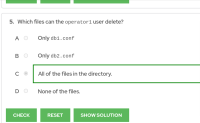-
Bug
-
Resolution: Duplicate
-
Minor
-
None
-
RH124 - RHEL9.0-en-4-20230227
-
None
-
7
-
en-US (English)
URL: https://rol.redhat.com/rol/app/courses/rh124-9.0/pages/ch07s02
Reporter RHNID: yuvaraj-rhls
Section: perms-fsperms-multchoice - Quiz: Interpret Linux File System Permissions
Language: en-US (English)|
Workaround:
Description: Description: These is an error in one of your question. On https://rol.redhat.com/rol/app/courses/rh124-9.0/pages/ch07s02 in question 5 you ask which files can the operator1 user delete and the answer you give is `both db1.conf and db2.conf`. However I set up the structure described in the question and operator1 can delete all of the files. This is because what governs deletion is the permission settings on the folder, not the file. The permissions on the files just mean that the user is prompted for deletion, they can still be deleted however. This is the text output. $ id $(whoami) uid=1003(operator1) gid=1003(operator1) groups=1003(operator1),1006(database1) ls ld . drwxrwxr-x. 2 operator1 database1 70 Feb 12 17:06 $ ls -l -rw-rw-r. 1 consultant1 consultant1 0 Feb 12 17:02 app1.log -rw-rrw. 1 consultant1 database1 0 Feb 12 17:02 app2.log rw-rw-r. 1 operator1 database1 0 Feb 12 17:02 db1.conf -rw-r----. 1 operator1 database1 0 Feb 12 17:02 db2.conf $ rm app1.log rm: remove write-protected regular empty file 'app1.log'? y $ rm app2.log rm: remove write-protected regular empty file 'app2.log'? y $ rm db1.conf $ rm db2.conf $ ls -l total 0 $
- is duplicated by
-
PTL-2747 RH124-759: clarify the correct quiz option to "all files can be deleted"
-
- Closed
-
